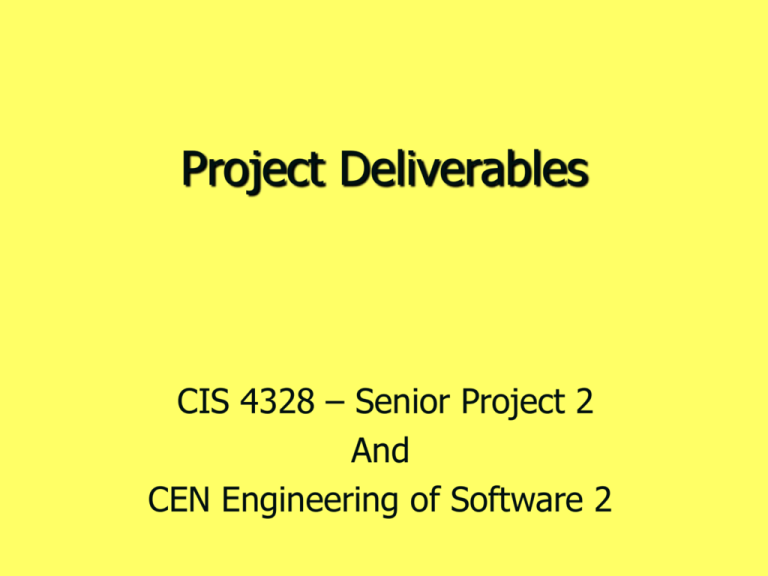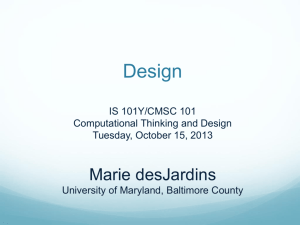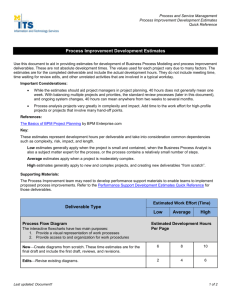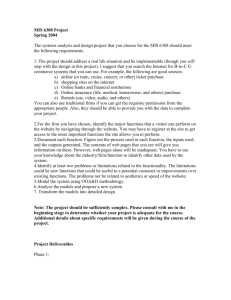Anticipated Deliverables
advertisement

Project Deliverables CIS 4328 – Senior Project 2 And CEN Engineering of Software 2 Second Semester Deliverables (anticipated) Deliverable #6 – User Interface Design and Revisited Analysis Modeling Deliverable #7 – Layered Architectural Design Deliverable #8 – Detailed Design - Iteration Planning and Use Case Realizations – Context Diagrams only. Deliverable #9 – Subsystem Design – Interaction Diagrams (both) and VOPC diagrams. Deliverable #10 –Class Design and Implementation #1; First Functional Demonstration Deliverable #11 – Final Deliverable: Complete Implementation Model and Demonstration including client testing. Deliverable 6 due: 1/23/2008 Start of class Two Key Components 1. Revisiting Analysis Model Use Case Specifications – Revisited Interaction Diagrams – Revisited 2. User Interface – Expanded and Revisited General Details on Deliverable 6 Don’t forget hard copies of peer reviews to be brought to class. This is important. When I bring up your CD, I should see one folder named Deliverable 6. As we add deliverables, the number of folders on your CD will increase and include a folder on Deliverable 7, etc. as we have done last semester. Within this Deliverable folder (and others throughout the semester) I should see a Revisit Deliverable 5 folder (or other deliverable number as appropriate), a Management Folder, and an Artifacts Folder unless advised otherwise. The Revisited Deliverable5 Folder is to contain the revisited Use-Case Specifications and the Revisited Interaction Diagrams (that is, Rose Model) The Management Folder is to contain the TeamNumFile, Executive Summary, Statement of Work, a folder containing Individual Schedules, a Traceability Document, and a SQA Report. (The Traceability Matrices should appear in a separate document called Traceability). The Artifacts Folder is to contain the User Interface Prototype (details ahead) 1. Details on Revisiting Analysis Model Use case specifications are to have hyperlinks to the Domain Model or to the definitions sections in your Glossary. These links are to be relative and must be accessible on my computer. Use case specifications are to provide a meaningful level of detail to support follow on design. If these specs are too high level and vague, they are unsatisfactory; too low level, and they constrain design. Interaction Diagrams – Sequence. All Alternatives and Exceptions are to contain hot links as appropriate, a concluding action (return to Step n or Use-case terminates here), and the complete set of behaviors. There are to be no database references in your use-case specifications unless these refer to an external system. Ensure these are correct. Additional example(s) may be found on my web page. The use-case specification text should be inserted down the left margin of your sequence diagrams approximately in line with the objects that realize the behaviors to the right. This effort supports traceability. Ensure control classes are indeed control (orchestrate) and entity classes provide core responsibilities and functionality. (Previous deliverables indicated that there was a real disconnect in understanding what these analysis class behaviors should be. In many cases, entity responsibilities were allocated to control classes.) Boundary classes are not to be expanded into ‘forms’ or ‘windows’ or anything resembling implementation. Remember, these will likely not morph into design classes. These are to appear in your Rose Model as appropriate in the Logical View folder. 2. User Interface – Expanded and Revisited I should be able to access the your UI within your deliverable submitted to me and execute it successfully. I should be able to navigate from screen to screen to pursue some scenario from a use case. I should NOT have to hunt and peck and wonder… Recognize that some (a few) of the windows / displays will be / may be hard coded and that demonstrated functionality may not be totally backed up with implemented code or efficient algorithms. But the implied functionality must be clear. More should be implemented than in Deliverable 3. User Interface - more This should be a significant refinement of your initial user interface prototype based on your increased knowledge and understanding of the requirements. This user interface should demonstrate the vast majority of key items of functionality as found in the use cases. In your classroom and field presentation, you are to demonstrate how your UI satisfies required functionality. Utility and Usability Principles as cited in the lecture slides and your text will be emphasized in evaluation. Verify your UI by running it against your use cases to ensure all functionality is captured.




